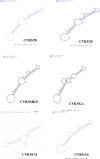The whole genome sequence of coxsackievirus B3 MKP strain leading to myocarditis and its molecular phylogenetic analysis
- PMID: 24555514
- PMCID: PMC3996064
- DOI: 10.1186/1743-422X-11-33
The whole genome sequence of coxsackievirus B3 MKP strain leading to myocarditis and its molecular phylogenetic analysis
Abstract
Background: In recent years, the reported infection cases by coxsackievirus (CV) have been on the rise. In order to reveal the relationship between the nucleotide and amino acid sequences and the viral virulence of the CVB3/MKP strain causing myocarditis, we initially confirmed the virulence of the strain in myocardial tissue and then carried out the whole genome sequencing of CVB3/MKP strain and performed a phylogenetic analysis among different CVB3 strains.
Methods: CVB3/MKP infected mouse model was established to check lesions of myocardial tissue in mice using immunohistochemical detection at different periods. RT-PCR analysis was used to amplify seven fragments covering the whole viral sequence and comparable analysis was performed.
Results: The immunohistochemical results showed that particles of CVB3/MKP virus persisted in the cardiac tissue and caused severe pathology. The length of whole genome sequence of CVB3/MKP strain was 7400 bp. CVB3/MKP had 99.7% and 99.6% homology in nucleotide sequence with CVB3/28 and non-virulent CVB3/0, respectively. The former can induce pancreatitis and myocarditis. The nucleotide sequence in the 5'untranslated region of CVB3/MKP strain shared 99.6% and 99.5% homology with CVB3/20 and CVB3/Nancy, respectively.
Conclusion: We confirmed in our animal experiments that CVB3/MKP had cardiotoxicity. CVB3/MKP, CVB3/28, and CVB3/0 may share evolutionary convergence and the 5'untranslated region (5'UTR) may be associated with virulence phenotype. Our findings will provide a basis for identifying the genomic determinant of viral virulence of CVB3/MKP strain and phylogenetic relationship among different CVB3 strains.
Figures





References
Publication types
MeSH terms
Substances
Associated data
- Actions
LinkOut - more resources
Full Text Sources
Other Literature Sources

